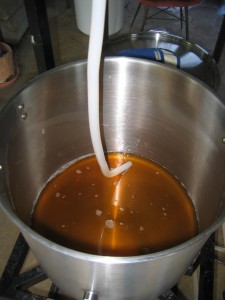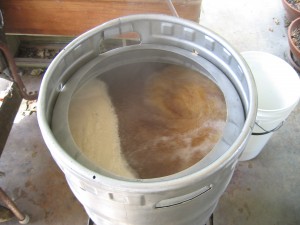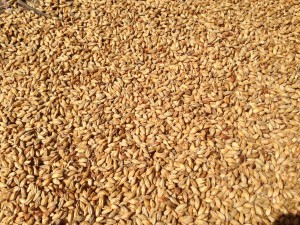Parti-gyle brewing is usually explained to homebrewers as a way to brew a strong beer from the first wort and a second, weaker beer from the sparged wort. A frequent variant is for the brewer to use the first third of his collected wort for the high-gravity beer and the remaining two-thirds for the weaker brew. Multiple homebrew sources state that half of the total extract will be in the first third of the wort. So, for example, if you collected 3 gallons of wort at SG 1.080, you would have 6 gallons of wort at SG 1.040 for your second beer. You could make your first beer solely from first wort and your second beer entirely from sparged wort. However, as we saw yesterday, this is a recipe for a lackluster second beer. Today let’s look at how you would brew a big beer and a little beer, presuming you planned to blend the first wort and sparged wort to yield better beers than could be made from either of them alone.
Our Example
For this example, let’s say we have a 10-gallon (38 L) mash tun and two kettles, 10 gallons (38 L) and 15 gallons (57 L). We want to make a big beer from the first wort, and a second beer from the sparged wort. However, we realize that we need some first wort blended into the second beer. This will give the second wort some protein (and peptides and amino acids) to aid yeast nutrition. It will also add malt aroma and some extract to the second beer. (Here, “extract” means carbohydrates and other things that contribute to the dissolved solids in the wort, not malt extract.)
Secondarily, let’s realize that adding some sparged wort to the first wort will benefit it, at the expense of diluting it slightly. Adding some sparged wort to your first wort will lower the protein level slightly, leaving the beer less prone to haze. Likewise, the small amount of tannins added will benefit the first wort beer. The amount of tannin from a small amount of sparged wort will not be enough to make the strong beer astringent, but it will improve the malt character. Studies in which all of the tannins were removed from a beer showed that beer drinkers found them less appealing.
So let’s say we want to first collect the two worts, then blend them so that our first beer is made from 80% first wort and 20% sparged wort and our second beer is made from 80% sparged wort and 20% first wort. Here’s how we could do it:
The First and Second Worts
Let’s say our grist comprises 24 lbs. (11 kg) of malted barley, including base malts and some specialty malts. At 75% extract efficiency, fully sparging our grain bed would yield 15.6 gallons (59 L) of pre-boil wort at SG 1.043. If our mash thickness is 1.25 qts./lb.(2.6 L/kg), then we will need 7.5 gallons (28 L) of strike water. Assuming our grains absorb 0.12 gallons/lb. (1.0 L/kg), we’d expect the grains to absorb 2.88 gallons (10.9 L) of water, leaving 4.62 gallons (17.5 L) of first wort. At 75% extract efficiency and our mash thickness, the OG of the first wort should be in the ballpark of SG 1.080. (This last value is based on experience, not calculated, and will vary depending on a variety of factors. These include how finely you crush the malt and if the mash is stirred.) If we have 4.6 gallons (17 L) of first wort, then we should have 11 gallons (42 L) of sparged wort. To figure out the specific gravity of the sparged wort, we solve this equation:
C1V1 + C2V2 = C3V3, where V1+V2 = V3
in our case:
4.6(80) + 11(x) = 15.6(43)
x= 28, so we have 11 gallons (42 L) of pre-boil wort at SG 1.028
This is in the ballpark of the observation that the first third of the wort contains roughly half (50%) of the extract. In our example, the first third contains 58% of the extract.
Blending Proportions
So, we have 4.6 gallons (17 L) of pre-boil first wort at SG 1.080 and 11 gallons (42 L) of pre-boil sparged wort at SG 1.028. If we brewed with them separately, we could yield 3 gallons (11 L) of wort OG 1.122 after a hard, 1-hour boil and 8 gallons (30 L) at OG 1.039 after a 2-hour boil — a big barley wine and British bitter, for example. However, we want to blend the worts so that each has 20% of the other mixed into it. The math to do that is fairly advanced. (And by that I mean I’ve forgotten almost everything I ever knew about differential equations). But, we can approximate this percentage by starting with the larger of the two worts. Multiplying 11 gallons (42 L) times 0.25 yields 2.75 gallons (10.4 L). Adding this volume of first wort to the sparged wort makes 4 parts sparged wort to 1 part first wort, or 80% sparged wort and 20% first wort, exactly.
Now, we had 4.6 gallons (17 L) of first wort, but 2.75 gallons (10.4 L) of it is reserved for blending. This leaves only 1.85 gallons (7.00 L) of first wort for our big beer. Multiplying this by 0.25 gives 0.46 gallons (1.75 L). So, if we add 0.46 gallons (1.75 L) of sparged wort to our first wort, we have the same 4:1 ratio, only reversed — 80% first wort and 20% sparged wort, exactly. The problem with the math is that now we really only have 10.5 gallons (40 L) of sparged wort, so adding the amount of first wort above yields slightly over 20% first wort. We can solve this one of two ways, going back to college and brushing up on our math skills, or recognizing that the difference here is small and just accept it. I’m going to pick the latter.
After Blending And Boiling
So, if we remove the two blending fractions first, then make our two blends we end up with 2.3 gallons (8.7 L) of blended, pre-boil wort at SG 1.070. (This was calculated using the same equation as above.) We also have 13.3 gallons (50.3 L) of wort at SG 1.039. [And, as a double check of our math, 2.3(70) + 13.3(39) does indeed equal 15.6(43).] We could boil these down to 2.0 gallons (7.6 L) at OG 1.081 and 10 gallons (38 L) at OG 1.052 — an old ale and a pale ale. The big beer would take a light 1-hour boil, the smaller beer a 2-hour boil. If we boiled the big beer harder or longer, we’d get higher-gravity wort, but at a smaller volume. For example, we could boil the stronger wort down to 1.3 gallons (4.9 L) in about an hour, and yield a wort of OG 1.124
Conclusion
So, if you’re looking to make a very big beer, but “rescue” your second wort with an infusion of first wort, you lose a lot of volume in the process. Additionally, if you blend sparged wort into the first wort, your specific gravity decreases, albeit with an increase in volume. In this example, I used 20% as the amount of first wort used to “rescue” the second beer. From an admittedly small number of trials over the years, I would guess that this is the minimum amount required.
If the big beer is really your goal, you’re better off either writing off the sparged wort,or supplementing it with wort from another source. In our example, 5.0 lbs. (2.3 kg) of dried malt extract could have made the 2.75 gallons (10.4 L) of wort at SG 1.080. Of course, this is not equivalent to first wort, and would not be as aromatic as first wort. Eight pounds (3.6 kg) of pale malt could make an equivalent wort and 14 lbs. (6.4 kg) of pale malt could yield that much first wort (leaving 6.4 gallons/24 L of sparged wort). Using wort from an outside source to “rescue” our second beer, we could have had 5.8 gallons of wort at 1.070 — a 4:1 blend of SG 1.080 to SG 1.028 worts.
Tomorrow, we’ll look at a case of making two beers from the same mash, this time with a smaller difference between the volumes and wort densities.





Speak Your Mind